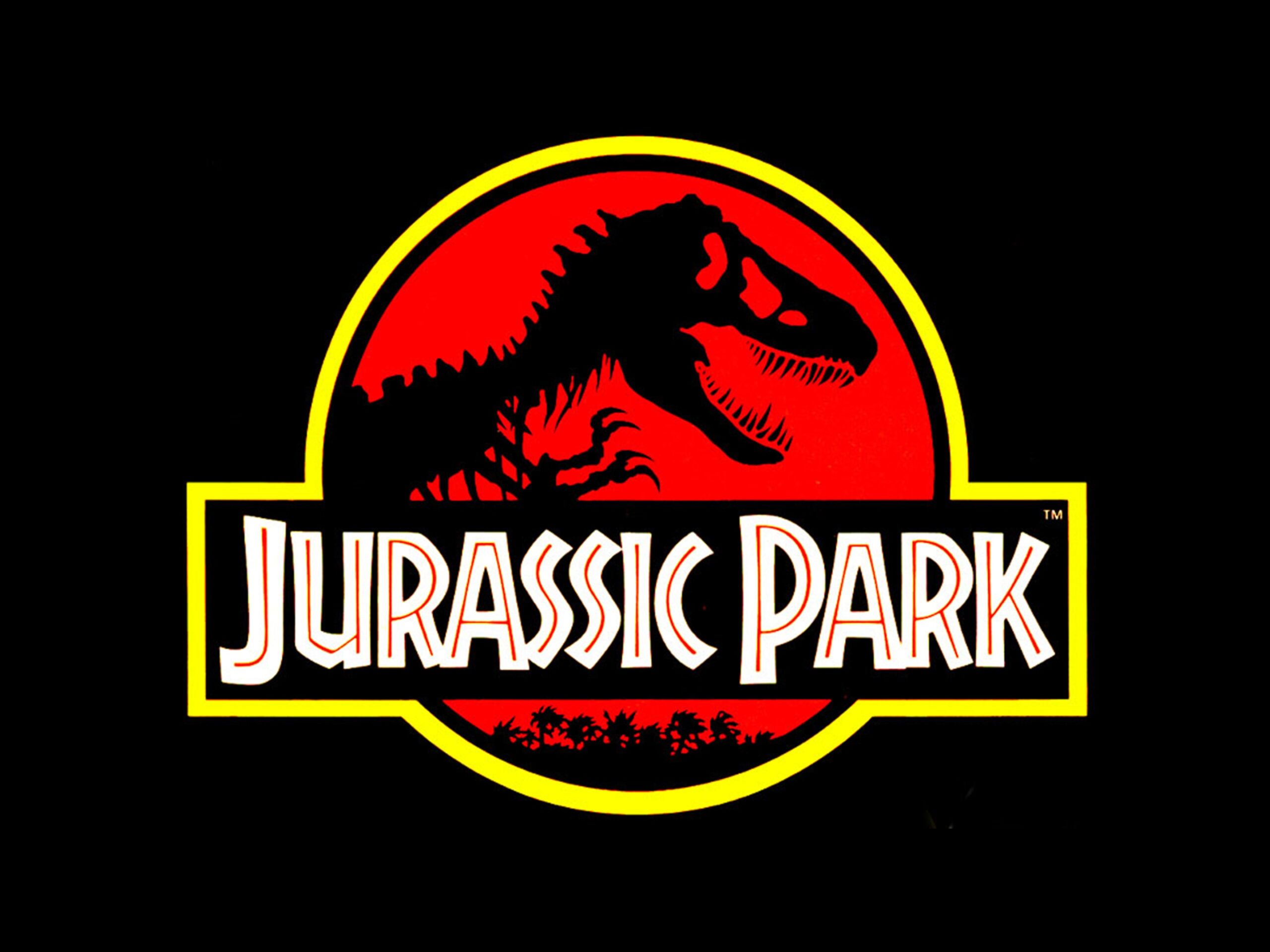By Chlo Hickson
Jurassic Park… Where do I begin with this one?
The film is set on the fictional island of Isla Nublar, located off Central America’s pacific Coast near Coasta Rica. There, wealthy businessman John Hammond and a team of scientists have created a wildlife park of dinosaurs. When business related sabotage leads to catastrophic shutdown of the parks power, a small group of visitors and Hammond’s grandchildren struggle to survive and escape the island.
There have surprisingly been few good dinosaur movies, despite a timeless fascination people continue to have with them. Dinosaurs haven’t been too well represented on film, it also doesn’t help matters when the attempts to bring them to life on screen have been comical or inadequate due to ignorance and the limits of special effects at the time. This is obviously no longer a problem thanks to technology we can bring these animals back to life with more believability than ever before, and there’s one movie that we have to thank for this, and everyone should know what that movie is.
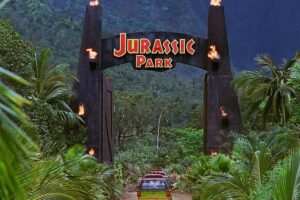 Directed by Steven Spielberg, based on the book of the same name by Michael Crichton, Jurassic Park took the world by storm when it was released in the summer of 1993 becoming the highest grossing movie of that year. It’s made believable by its game changing effects, making the dinosaurs feel real in a way they hadn’t been before. After Jurassic Park no dinosaur movie has ever matched its greatness and it still remains that way today, but why? What is it about Jurassic Park that specifically makes it the king of dinosaur movies? The Jurassic franchise has had five sequels and yet none of them are as good as the original. There of course are obvious reasons as to why this is: Spielberg’s direction, John Williams iconic score, and the ground-breaking effects all play a large part when it comes to what makes Jurassic Park a great movie. Upon further reflection I think it’s more than this. It takes the science seriously. The three main leads are doctors, this automatically frames the story with an academic context. The film isn’t about an ordinary person seeing these dinosaurs it’s about people who have dedicated their lives to the studying of these extinct beings, the very thing they are passionate about coming to life right in front of their eyes. Jurassic Park takes its science so seriously that they took the time to show how they brought dinosaurs back to life with the characters, the fact that the movie goes out of its way to explain the science oddly makes the story feel more magical. It’s the magic of science. It’s also a warning of man’s arrogance no matter how well our intentions may be. Although Jurassic Park does have the dinosaurs eating people it actually fits the theme of the story, be careful what you wish for. Nature doesn’t care about your feelings or intentions; it’ll lash out and not comply with your demands. It’s a force greater than ourselves that we can’t control, and the dinosaurs are a manifestation of that force. Every shot of the dinosaurs is focused and commands your attention.
Directed by Steven Spielberg, based on the book of the same name by Michael Crichton, Jurassic Park took the world by storm when it was released in the summer of 1993 becoming the highest grossing movie of that year. It’s made believable by its game changing effects, making the dinosaurs feel real in a way they hadn’t been before. After Jurassic Park no dinosaur movie has ever matched its greatness and it still remains that way today, but why? What is it about Jurassic Park that specifically makes it the king of dinosaur movies? The Jurassic franchise has had five sequels and yet none of them are as good as the original. There of course are obvious reasons as to why this is: Spielberg’s direction, John Williams iconic score, and the ground-breaking effects all play a large part when it comes to what makes Jurassic Park a great movie. Upon further reflection I think it’s more than this. It takes the science seriously. The three main leads are doctors, this automatically frames the story with an academic context. The film isn’t about an ordinary person seeing these dinosaurs it’s about people who have dedicated their lives to the studying of these extinct beings, the very thing they are passionate about coming to life right in front of their eyes. Jurassic Park takes its science so seriously that they took the time to show how they brought dinosaurs back to life with the characters, the fact that the movie goes out of its way to explain the science oddly makes the story feel more magical. It’s the magic of science. It’s also a warning of man’s arrogance no matter how well our intentions may be. Although Jurassic Park does have the dinosaurs eating people it actually fits the theme of the story, be careful what you wish for. Nature doesn’t care about your feelings or intentions; it’ll lash out and not comply with your demands. It’s a force greater than ourselves that we can’t control, and the dinosaurs are a manifestation of that force. Every shot of the dinosaurs is focused and commands your attention.
It doesn’t just have people running from dinosaurs, it has ideas, themes, scientific curiosity and the dangers that lie with it. It works as a fun adventure movie but has layers to it if you want to look for them. There isn’t a movie like it and its possible there never will be again.
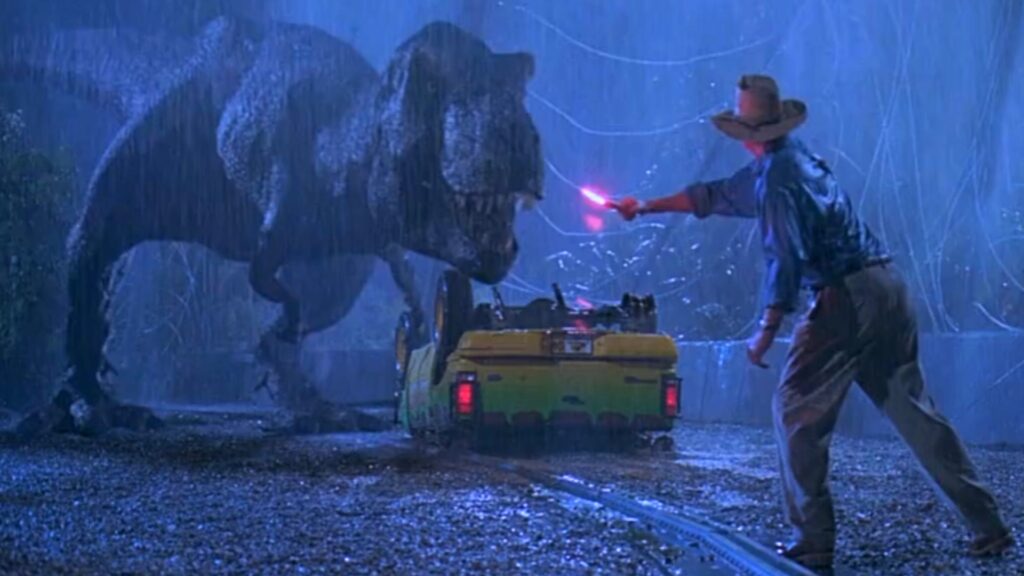 It stars Sam Neill as palaeontologist Alan Grant, Laura Dern as Ellie Satler a palaeobotanists and the charismatic Jeff Goldblum as chaos theorist Ian Malcom. However, the stars are the dinosaurs who are a combination of CGI and animatronics. The dinosaurs are realistic, lifelike, beautiful and completely terrifying with my favourites being the T Rex and the raptors.
It stars Sam Neill as palaeontologist Alan Grant, Laura Dern as Ellie Satler a palaeobotanists and the charismatic Jeff Goldblum as chaos theorist Ian Malcom. However, the stars are the dinosaurs who are a combination of CGI and animatronics. The dinosaurs are realistic, lifelike, beautiful and completely terrifying with my favourites being the T Rex and the raptors.
The dialogue and acting are so good that you start to relate to the characters, you care for these people. Because of this, by time they are going to the island you feel as though you’re going with them. The same goes for when they are in danger, you feel that threat. The different cast members in this film are great. The children’s reactions to the dinosaurs are very believable, especially in the raptor kitchen scene.
Entire scenes are dedicated to characters discussing whether or not technology gives us the control we have as a species, and when they aren’t scenes will take their time to establish atmosphere, tension, mood, character personalities and motivation and it all combines to make each scene iconic and stand out from the rest. There is a two-minute scene where a lawyer talks to a palaeontologist about investors wanting a thorough insight inspection of their investment and as boring as that sounds its incredibly well handled. It directly contrasts the dark and chaotic scene that proceeds it. Characters aren’t just standing still but walking through a wide dig sight with builders’ voices echoing throughout the scene, and lastly it takes you deeper into the world and pulls you in with mood, intrigue and mystery leaving you with the impression that something bigger is at play. That we, as an audience, are only getting small glimpses at what this story has in store for us. It’s a whole journey and it’s just a two-minute scene. Every scene is like this, taking its time to entice the viewer into the world and even though it doesn’t look like this on the surface, the subject matter might not be the most thrilling but by giving it some thought it makes you even more curious. So many movies today don’t do this, instead they interrupt the flow of dialogue with jokes. In Jurassic Park tension is maintained and never sacrificed for jokes and if there is a joke it’s enough to make you laugh but not enough to make you distracted by what’s happening on the screen.
It’s clear from re-watching the movie that the movie is most impressive because of its screenplay. While the film is filled with exciting action sequences and amazing visual effects, it’s also populated by its characters that are used to explore an important modern theme.
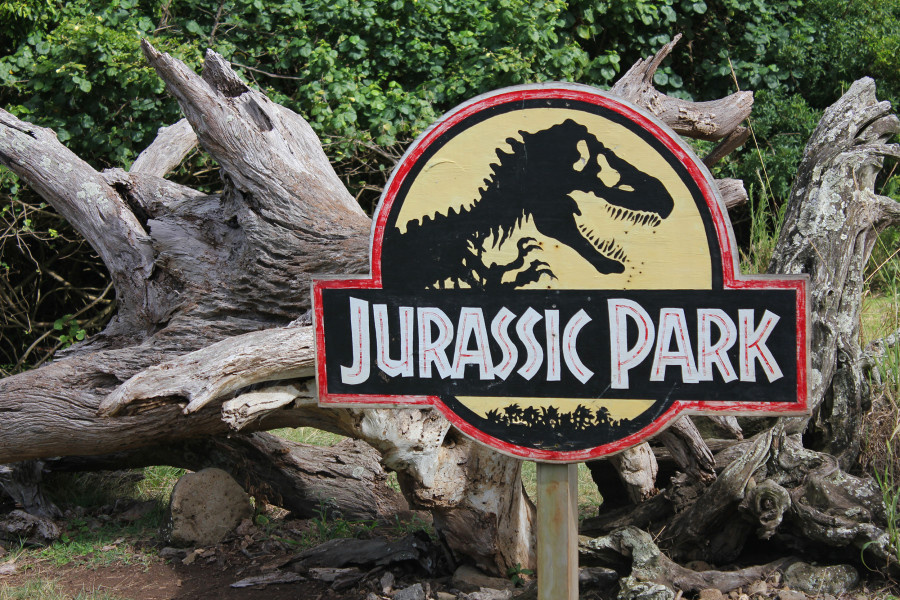 When thinking about who would be able to pay for something like this became a challenge to Crichton, the theme of Jurassic Park being an entertainment park became the proposition and buried inside this proposition he would find the DNA of the story. Its theme. Is it a good idea to bring back dangerous extinct creatures? Just because we have the technology doesn’t mean that we should, and is everything we call progress actually progress? This is the theme of Jurassic Park, but Michael didn’t think it had a simple answer, so he and screenwriter David Koepp used the theme as a blueprint for creating two characters with opposing viewpoints. When we first meet Dr. Alan Grant, he’s anti-progress in two ways. We see that he is completely mistrusting of technology, we also see that he isn’t compatible with a more significant representation of the future: Grant doesn’t like kids and doesn’t want to have them. Throughout the first half of the movie, we see examples of Alan’s dislike of children and his disdainful relationship with technology again and again and again. Grant clearly represents the anti-progress side of the theme but someone with an opposing viewpoint comes barging into his world: John Hammond. John is so pro-technology and progress he doesn’t even think that bringing dinosaurs back to life might be dangerous, when a worker is killer by a raptor Hammond’s only concern is that it might delay the parks opening. In fact, John’s favourite catchphrase ‘spared no expense’ is an expression of this mindset, forward at all costs. The first act of the movie establishes Grant and Hammond’s opposing takes of the theme of progress. Just doing this isn’t enough, to truly explore a theme we need to find ways of testing the character’s beliefs. In act 2 the screenplay splits these two with an entire island between them, this separation allows each of them to come across situations uniquely designed to attack their beliefs. When the power goes out all over the island Grant finds himself responsible for the lives of Hammond’s grandchildren, throughout the second half of the movie Alan’s story is about looking after the kids, eventually he even acknowledges that he has been resisting progress in his own life and he’s ready to change. Meanwhile Hammond is dealing with the fact that the dinosaurs he created are destroying everything he has built but even worse they are now threatening the lives of his grandchildren. By having to witness the disaster unfold John is forced to realise that he only loved progress when he thought he had control over it. But it’s not just the situations that are designed to attack Grant and Hammond’s beliefs. The script uses Dr. Ian Malcom to test Grant by flirting with his partner. In his interactions with Alan, we see that he might have qualities Dr Satler wants that Alan lacks. It hints that if he doesn’t evolve, he could lose Ellie. Malcom tests Hammond by spelling out the exact problem with his pro-progress obsession. Once Malcom entered Ellie also steps in to test John’s beliefs for weaknesses. The screenwriter even reminds us of Hammond’s catchphrase highlighting how Hammond’s progress at all cost viewpoint has failed in the face of disaster and now sits around him.
When thinking about who would be able to pay for something like this became a challenge to Crichton, the theme of Jurassic Park being an entertainment park became the proposition and buried inside this proposition he would find the DNA of the story. Its theme. Is it a good idea to bring back dangerous extinct creatures? Just because we have the technology doesn’t mean that we should, and is everything we call progress actually progress? This is the theme of Jurassic Park, but Michael didn’t think it had a simple answer, so he and screenwriter David Koepp used the theme as a blueprint for creating two characters with opposing viewpoints. When we first meet Dr. Alan Grant, he’s anti-progress in two ways. We see that he is completely mistrusting of technology, we also see that he isn’t compatible with a more significant representation of the future: Grant doesn’t like kids and doesn’t want to have them. Throughout the first half of the movie, we see examples of Alan’s dislike of children and his disdainful relationship with technology again and again and again. Grant clearly represents the anti-progress side of the theme but someone with an opposing viewpoint comes barging into his world: John Hammond. John is so pro-technology and progress he doesn’t even think that bringing dinosaurs back to life might be dangerous, when a worker is killer by a raptor Hammond’s only concern is that it might delay the parks opening. In fact, John’s favourite catchphrase ‘spared no expense’ is an expression of this mindset, forward at all costs. The first act of the movie establishes Grant and Hammond’s opposing takes of the theme of progress. Just doing this isn’t enough, to truly explore a theme we need to find ways of testing the character’s beliefs. In act 2 the screenplay splits these two with an entire island between them, this separation allows each of them to come across situations uniquely designed to attack their beliefs. When the power goes out all over the island Grant finds himself responsible for the lives of Hammond’s grandchildren, throughout the second half of the movie Alan’s story is about looking after the kids, eventually he even acknowledges that he has been resisting progress in his own life and he’s ready to change. Meanwhile Hammond is dealing with the fact that the dinosaurs he created are destroying everything he has built but even worse they are now threatening the lives of his grandchildren. By having to witness the disaster unfold John is forced to realise that he only loved progress when he thought he had control over it. But it’s not just the situations that are designed to attack Grant and Hammond’s beliefs. The script uses Dr. Ian Malcom to test Grant by flirting with his partner. In his interactions with Alan, we see that he might have qualities Dr Satler wants that Alan lacks. It hints that if he doesn’t evolve, he could lose Ellie. Malcom tests Hammond by spelling out the exact problem with his pro-progress obsession. Once Malcom entered Ellie also steps in to test John’s beliefs for weaknesses. The screenwriter even reminds us of Hammond’s catchphrase highlighting how Hammond’s progress at all cost viewpoint has failed in the face of disaster and now sits around him.
Ian Malcom, Ellie Satler, Dennis Nedry, and Robert Muldoon are fun additions to the story each with their own moments, but more importantly these characters exist to sharpen the films focus on theme by challenging the thoughts of Grant and Hammond. Because their beliefs are challenged throughout the film by the end, they have both learned to evolve. The fact that they both change their beliefs is proof that the question that is being asked doesn’t have a neat easy answer.
Jurassic Park is a great example of how to use theme at the design of the screenplay. It celebrates the miracles the technology can provide while also warning of the dangers of irresponsible progress. This commitment to theme elevates the film above any monster movie, helping it become one of our most beloved cinematic experiences. It allowed one meaningful adventure to wait inside the gates of Jurassic Park.
Something else that I think makes Jurassic Park great is its ability to build emotions through cinematic techniques. The music is cheery, and our excitement grows, suddenly the music stops as Ellie looks in confusion and wonder at a plant that shouldn’t exist anymore and Alan looks at something in the distance, mouth agape as the camera zooms in on him. He takes off his hat and glasses and stands up as if he can’t believe his eyes. Its only then when Alan gets her attention that Ellie takes off her glasses and rises out of the roof of the car with subtle suspenseful music and then we hear it and in the same moment see it as the enormous Brachiosaurus towers over them emitting a beautiful animal call then the iconic music kicks in again sealing us in a sense of wonder and magnificence as the main characters stumble out of the car and walk up to the creature in bewilderment. This animal they have admired their entire lives, which Alan in particular has spent his whole career studying stands next to him. Every character gets their own moment showing what it means to them, and Alan gets so overwhelmed that he gets dizzy and must sit down. This is where John Hammond joyfully exclaims ‘welcome to Jurassic Park’. We then see a wide shot of the full majesty of the park with herds of dinosaurs together wondering across the field and lake. This is what I mean by building emotion. Speaking about Williams’ incredible score, the main theme has this warm regal feeling and lives up to the audiences’ expectations of seeing dinosaurs for the first time. The score just adds to everything. John Williams’ instantly recognisable score couldn’t be any more of a perfect match for this movie, from its iconic theme to its more ominous feeling tracks that reflect the feeling of discovering something ancient but also forbidden, a Pandora’s box of power that can’t be controlled. When they arrive at the island this brilliant triumphant music plays and it’s so happy and grand and then it turns into this enchanting little adventure but then it gets quiet and it builds and builds and builds and then there’s this beautiful majestic music plays hand in hand with characters in awe of this incredible life in front of them and you can’t help but share in their wonder, but then you get to the T Rex scene and the music is gone. Rain, thunder, and silence replaces the score that was once comforting until the park goes from this wonderful destination to this very real and terrifying island full of extinct wild animals destroying the barrier between fantasy and reality. Just hearing this music sends you back into this world where it compliments it perfectly.
Based on the Dinonicaus, Steven Spielberg’s Velociraptor became an overnight hit after being the “big bad” of Jurassic Park. One of the many things that Spielberg did fantastically in this movie was set up and pay off, so many scenes and lines serve to set up another moment or reveal later on. When Alan is frightening the kid about the raptors, he says about the ability of T Rex’s not being able to see you if you don’t move, this scene pays off when Rexy escapes and he tells Lex the same thing. The scene where Hammond telling Alan and Ellie how fast the T Rex can run then brings us to the scene where she chases the car. But when it comes to setting up a villain nothing comes close to the Velociraptor. The opening, Alan’s monologue, the baby hatching and the feeding scenes are all crucial in getting the audience to fear the inevitable raptor reveal.
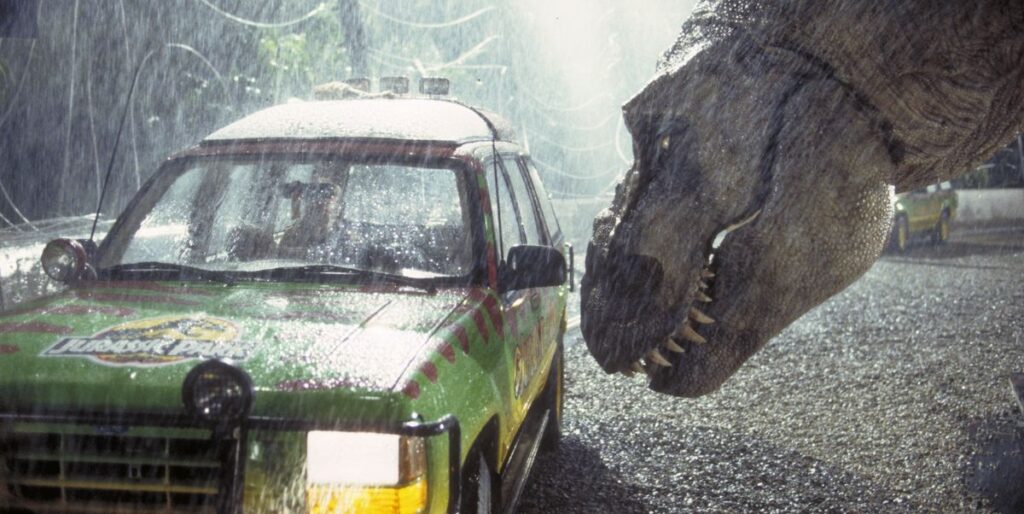 Jurassic Park opens with the workers eagerly anticipating a delivery, many with weapons drawn, whatever is being delivered is really dangerous. Just a few short moments later someone becomes lunch, although we haven’t seen what dinosaur did this a sense of uneasiness lingers over the audience. A few seconds forward and we’re at a dig site in Montana where they are digging up a Velociraptor skeleton. Alan then informs us how these creatures would’ve hunted. This third moment is subtle but is the best. Alan’s reaction to the baby raptor. The dialogue in this scene has pointed to dinosaurs being warm blooded making the carnivores far more active predators like lions and wolves who produce their own heat as opposed to crocodiles and reptiles who use the sun and can only attack in short bursts, this means they were quick and energetic instead of slow which is how dinosaurs were portrayed previously in other Dino media. So extra deadly. This isn’t what I was going to originally reference though, Dr Grant’s reaction to learning about the Rex made him go into shock but when he hears Dr Wu say it’s a Velociraptor, he gets frightened. Lastly there’s the feeding scene. It’s here we witness what kind of damage Velociraptors can do. A lot more set up also comes from this scene, it’s here that Robert Muldoon explains to Alan what the raptors are like. Alan knew they were deadly predators but not this deadly. Next, we learn about the alpha of the pack ‘The big one’ as she’s referred too. And finally, the intelligence is brought up, Velociraptors aren’t just fast and armed with deadly claws. They are smart, thinking, problem solving intelligent. At the end the raptors break out and are revealed to us in full and are as terrifying as they are hyped up to be. All the set ups get paid off. This coupled with their chilling sounds, special effects and great performances really sell the intimidation and helped the Velociraptor to be a truly menacing on screen presence.
Jurassic Park opens with the workers eagerly anticipating a delivery, many with weapons drawn, whatever is being delivered is really dangerous. Just a few short moments later someone becomes lunch, although we haven’t seen what dinosaur did this a sense of uneasiness lingers over the audience. A few seconds forward and we’re at a dig site in Montana where they are digging up a Velociraptor skeleton. Alan then informs us how these creatures would’ve hunted. This third moment is subtle but is the best. Alan’s reaction to the baby raptor. The dialogue in this scene has pointed to dinosaurs being warm blooded making the carnivores far more active predators like lions and wolves who produce their own heat as opposed to crocodiles and reptiles who use the sun and can only attack in short bursts, this means they were quick and energetic instead of slow which is how dinosaurs were portrayed previously in other Dino media. So extra deadly. This isn’t what I was going to originally reference though, Dr Grant’s reaction to learning about the Rex made him go into shock but when he hears Dr Wu say it’s a Velociraptor, he gets frightened. Lastly there’s the feeding scene. It’s here we witness what kind of damage Velociraptors can do. A lot more set up also comes from this scene, it’s here that Robert Muldoon explains to Alan what the raptors are like. Alan knew they were deadly predators but not this deadly. Next, we learn about the alpha of the pack ‘The big one’ as she’s referred too. And finally, the intelligence is brought up, Velociraptors aren’t just fast and armed with deadly claws. They are smart, thinking, problem solving intelligent. At the end the raptors break out and are revealed to us in full and are as terrifying as they are hyped up to be. All the set ups get paid off. This coupled with their chilling sounds, special effects and great performances really sell the intimidation and helped the Velociraptor to be a truly menacing on screen presence.
Which brings me to something not many people talk about. Jurassic Park is a thinly veiled horror movie, one that doesn’t have a definitive villain, we have quite a few things to blame: the dinosaurs themselves, the scientists who brought them back to life, John Hammond and Dennis Nedry. Short answer is all of the above. But this allowed the film to be a lot less predictable than horror movies like Halloween or Nightmare on Elm Street when it comes to blaming and establishing who or what to fear. Real horror comes from how the film is staged and how each scene connects. Not many people believe me or think I’m looking too much into this movie when I say this so I’m going to explain why I think this, starting with the T Rex breaking out.
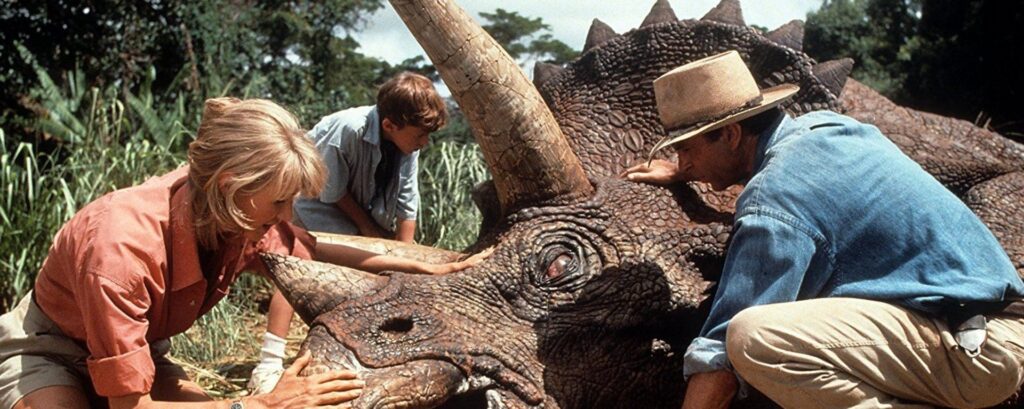 Most of the main cast is on the tour when the computer systems malfunction and the park go offline, characters are split between two of the cars with the two kids and the lawyer in the front car and Alan Grant and Ian Malcom in the second car. Weather on the island is getting worse as a storm strikes their visit. There’s no music, no tension, just the sound of thunder and rain. A sound everyone will recognize. The scene sets itself up with a goat inside of the fence that was left as food for something big. That’s when we hear our first unfamiliar sound that echoes from the distance. A cup of water ripples whenever the sound is made. The rain fades out as we focus on the lawyer who is focused on the sound. The thunderous noise gets louder, Tim looks through the night vision goggles and notices the goat is no longer on the chain and right when Lex asks where it is the goat’s leg lands on the sunroof of their car. We cut to a dinosaur’s arm slowly pulling away from the fence with a danger 10,000 volts sign, clearly showing us that the power is out. But it doesn’t tell us that, it shows us. Then from the view of the car we see the large head of the T Rex slowly rise as she eats the remainder of the goat with one bite before turning directly towards the car. The lawyer then runs out the car in a panic, abandoning the kids, heads for the bathroom. The next sound we hear on top of the rain is the creaking of the fence, the kids look around, and in full view we see the massive T Rex has escaped and proceeds to walk onto the road before giving a victorious roar.
Most of the main cast is on the tour when the computer systems malfunction and the park go offline, characters are split between two of the cars with the two kids and the lawyer in the front car and Alan Grant and Ian Malcom in the second car. Weather on the island is getting worse as a storm strikes their visit. There’s no music, no tension, just the sound of thunder and rain. A sound everyone will recognize. The scene sets itself up with a goat inside of the fence that was left as food for something big. That’s when we hear our first unfamiliar sound that echoes from the distance. A cup of water ripples whenever the sound is made. The rain fades out as we focus on the lawyer who is focused on the sound. The thunderous noise gets louder, Tim looks through the night vision goggles and notices the goat is no longer on the chain and right when Lex asks where it is the goat’s leg lands on the sunroof of their car. We cut to a dinosaur’s arm slowly pulling away from the fence with a danger 10,000 volts sign, clearly showing us that the power is out. But it doesn’t tell us that, it shows us. Then from the view of the car we see the large head of the T Rex slowly rise as she eats the remainder of the goat with one bite before turning directly towards the car. The lawyer then runs out the car in a panic, abandoning the kids, heads for the bathroom. The next sound we hear on top of the rain is the creaking of the fence, the kids look around, and in full view we see the massive T Rex has escaped and proceeds to walk onto the road before giving a victorious roar.
All this tension and build up with nothing but sounds, slow plotting visual cues and the feeling of knowing something’s about to happen. No idea when, how, or why. All of these elements are exactly what makes the most tension filled scenes in slasher movies. Silence, sound, slow realisation and terror in that order.
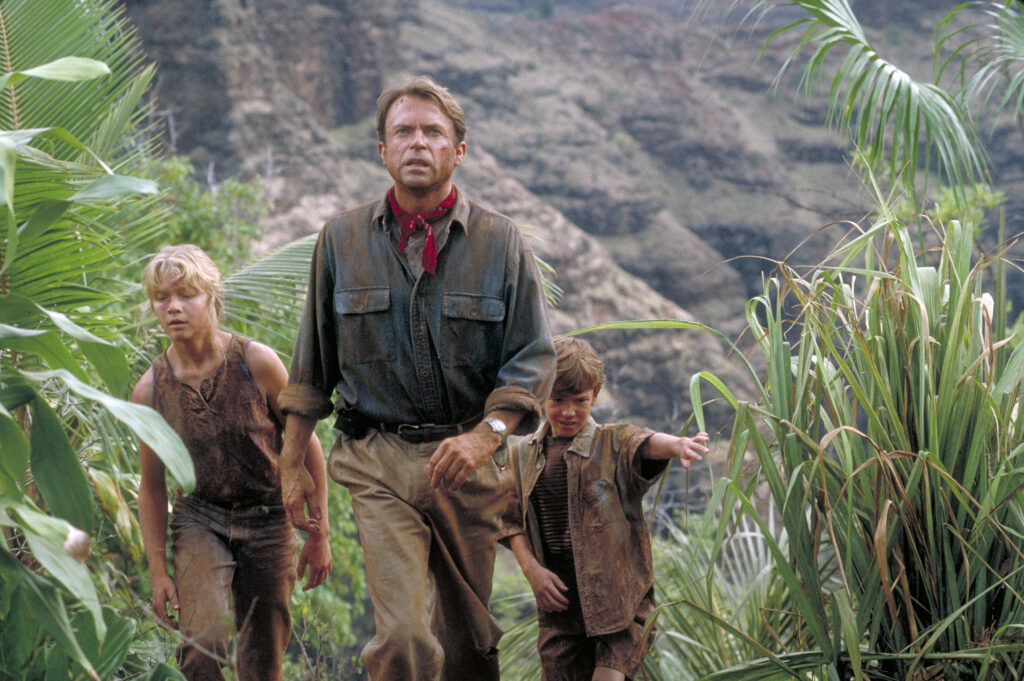
During this scene Alan states that Rexy’s vision is based of movement and to stay absolutely still. The camera then cuts back to the kids frantically moving around and turning on a torch. The dinosaur focuses her attention on them and goes to investigate what’s moving. Tim notices the front door is open from the lawyer leaving them and quickly slams it shut. This causes the T Rex to snap her head to the car and eventually gets the light from the torch shone directly into her eye. She roars, the kids move again, and she violently begins to attack the car. Breaking the sunroof glass, the piece of it becomes the only barrier between the kids and the Dino. The car is then flipped over and stomped on, and it slowly sinks into the mud.
Good horror does what we’ve got here, it quietly builds tension, shows the threat, shows the power of the threat and lets you fear it before finally exploding. This is horror 101, not action movie 101.
Alan and Malcolm both take turns distracting Rexy with flares, she chases Malcom, crashes into the bathroom that breaks apart completely revealing the lawyer and to show that there are real consequences to the horror that’s been built up and not everyone will make it out alive, the danger is serious and to amplify this fear the T Rex eats the lawyer. Not hidden by anything, no camera cutting away, we get to see it. And from there the chaos really begins. As Rexy spins the jeep around and attempts to eat children, we have the excitement of watching this dinosaur go to work while also fearing for the lives of the kids.
Another scene that is similar but less impactful is the raptor scene. Jurassic Park has proven time and time again that the raptors might be an even bigger threat then the T Rex.
We have Ellie and Muldoon going to see if they can fix the power, at the start of their journey they find out that the raptors have escaped and moments before reaching the power station they notice that something is stalking them. Muldoon is fixated on what appears to be a raptor that is tracking their movements. He instructs Ellie to run to the power station as he takes on the threat. Classic action movie cliché of distract and accomplish. Once in the station she turns on the power catching the attention of a rapture that bursts through the pipes behind her. She manages to escape and traps it, she’s then greeted by a hand on her shoulder which we know belongs to Ray Arnolds, we then find out it’s no longer attached to his body.
This time we got the reverse. Action, pause, horror.
Cutting back to Muldoon, before he can pull the trigger, another raptor peaks its head from the bushes before proceeding to jump at him and kills him. I love this scene as in the beginning Alan tells the kid how raptors hunt, you see the first staring at you and expect to get dived on, but since you were so focused you never knew there was a second raptor that attacked your side. Which is exactly what happened to Muldoon, and knowing this in the beginning, the audience can watch in anticipation since the guy who says to know everything about raptors is surprised by their hunting behaviours.
This is what Jurassic Park does brilliantly with the T Rex and the raptors. One hunts in packs and is fast, the other is alone and hunts at their leisure. They are two different enemies, and they are treated differently. The T Rex has a slow build of terror and tension, the raptors are fast jump scares. Again, another scene written like a slasher.
The last scene I’m going to use as an example is what sums up the horror of Jurassic Park better than any other scene.
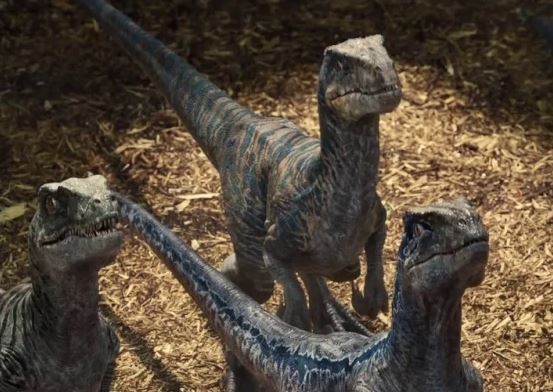 This raptor scene takes place after the previous one, we have the kids in a supposedly safe environment. While eating some jelly Lex is struck silent while shaking uncontrollably noticing a silhouette which happens to be a dinosaur approaching on the wall behind Tim. There’s a drawing of a raptor where the silhouette is symbolising the threat. The kids run to the kitchen and hide behind one of the counters, we see through the circular windows on the door the snout of a raptor breathing. We’re then told by Ellie that there are two raptors out there left as, one is contained unless it can open doors. Here’s another horror cliché. We establish what our villain’s weakness is, what they are not able to do, then sometime during the end of a movie horror is created by breaking that rule. We cut back to the kitchen where we see the handle of the door slowly turning and eventually opening, establishing that the element of safety isn’t there anymore. Now we have the classic raptor scene in the kitchen. The scene plays out as Ellie and the kids try rebooting the computer system of the park while Alan holds off the raptors from getting into the room. Ending in a near death, action escape, while raptors knock down the door and Lex hanging while having raptors dive for her feet. This leads to the final showdown with the humans being cornered by the raptors before being recused by their first dangerous encounter Rexy. Ending horror with action.
This raptor scene takes place after the previous one, we have the kids in a supposedly safe environment. While eating some jelly Lex is struck silent while shaking uncontrollably noticing a silhouette which happens to be a dinosaur approaching on the wall behind Tim. There’s a drawing of a raptor where the silhouette is symbolising the threat. The kids run to the kitchen and hide behind one of the counters, we see through the circular windows on the door the snout of a raptor breathing. We’re then told by Ellie that there are two raptors out there left as, one is contained unless it can open doors. Here’s another horror cliché. We establish what our villain’s weakness is, what they are not able to do, then sometime during the end of a movie horror is created by breaking that rule. We cut back to the kitchen where we see the handle of the door slowly turning and eventually opening, establishing that the element of safety isn’t there anymore. Now we have the classic raptor scene in the kitchen. The scene plays out as Ellie and the kids try rebooting the computer system of the park while Alan holds off the raptors from getting into the room. Ending in a near death, action escape, while raptors knock down the door and Lex hanging while having raptors dive for her feet. This leads to the final showdown with the humans being cornered by the raptors before being recused by their first dangerous encounter Rexy. Ending horror with action.
From the great action scenes to the beautiful scenery shots, there is nothing not to like in this movie. Every scene has been put together with care and it really shows. It was the dawning of believable CGI effects in movies, illustrating what could be done with the technology. It is also responsible for the death of animatronics. A considerably more time consuming and expensive form of special effects and far more constricting at what can be done. It is arguable that this shift was inevitable but Jurassic Park was a catalyst in this transition. Fortunately for all of us it is also a triumph. As smart as it is technically inventive and as harrowing as it is emotionally resonating. Jurassic Park is Spielberg at the top of his game. If you are a person who loves horror, sci-fi, adventure, dinosaurs or Spielberg movies in general then I can’t recommend Jurassic Park enough. The 1st T Rex encounter, Velociraptors in the kitchen and the T Rex fight at the end are some of the greatest scenes in the franchise. Overall, a great, influential work of art that was ahead of its time. A true masterpiece.
🌟 🌟 🌟 🌟 🌟

